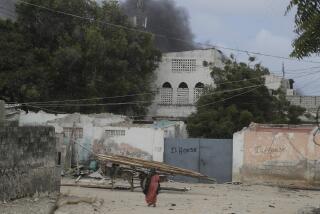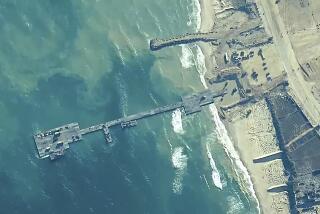2 Somalis Killed, 7 Hurt at French Roadblock : Security: Victims on truck include women and children. Chiefs of nation’s warring factions will meet.
- Share via
MOGADISHU, Somalia — While diplomatic efforts to bring together Somalia’s warring clans took a major step forward Thursday, the U.S.-led military operation here claimed its first civilian casualties when sentries at a French roadblock opened fire on a truck loaded with men, women and children.
Shortly after dark, at a military checkpoint near the new French Foreign Legion garrison in downtown Mogadishu, soldiers fired more than a dozen rounds at the civilian vehicle, killing two and injuring seven.
French Col. Michel Touron said the unarmed truck had run the roadblock manned by French soldiers and U.S. Marines, who also joined in the shooting. He asserted that the shooting was justified under the American commander’s “rules of engagement.” Those rules allow soldiers to fire on any individual showing “hostile intent.”
After the soldiers opened fire, the driver lost control and the truck smashed into a wall. Among the dead and injured were women and children with gunshot wounds.
The roadblock was one of several set up around the city by American and French troops, who are authorized by the United Nations to restore order and help move famine aid in this starvation-ridden, war-torn nation.
Occasional gunfire was heard elsewhere around Mogadishu on Thursday, but the streets were also filled with pedestrians and shops reopened in the second straight day of a new-found sense of order.
Bolstering confidence in the mission here was an announcement by American officials that two powerful clan leaders, whose warring factions have destroyed much of the city, agreed to meet today in the residence of Robert Oakley, the U.S. special envoy to Somalia. Many here hope that the meeting, the first in more than a year, may lead to an end of the war that also has crippled the famine relief effort.
“This could be the solution to Somalia’s long-term problems,” Oakley said.
In other developments Thursday:
* Lt. Gen. Martin L. Brandtner told reporters at the Pentagon that American troops will launch their drive today into Somalia’s starved, violent interior.
* Gen. Robert P. Johnston, the Camp Pendleton-based official who will command the American forces in Somalia, arrived with his staff in Mogadishu after a 22-hour flight from the United States. He said he was “impressed with the operation, so far.”
* An advance party of Seabees and tons of cargo left Port Hueneme to prepare camp in Somalia for hundreds more naval construction workers who will build roads, galleys and other facilities for the U.S. Marine-led relief effort.
* The United Nations said Secretary General Boutros Boutros-Ghali also had invited the rival Somali warlords to meet him in Addis Ababa, Ethiopia, on Jan. 4. Other Somali leaders also would join the talks, which the United Nations said would focus on preparing “for a national reconciliation conference.”
In Washington, Gen. Brandtner told reporters at the Pentagon on Thursday that American troops will move into Baidoa and Bela Dogle beginning today.
Brandtner said the Bela Dogle airfield, 40 miles west of Mogadishu, will have a limited ability to accommodate the Air Force’s large C-141 aircraft, as well as the smaller C-130s. Bela Dogle is in an area of relative calm and security in comparison with Baidoa, described by Pentagon officials Thursday as “tense.” Factional forces gathered outside Baidoa, maneuvering for the best positions and forcing relief workers to evacuate the area.
In Kismayu, looting and fighting have caused 100 casualties in recent days and caused relief workers to flee the violence, reported Rear Adm. Michael Cramer, a top American military intelligence official.
Cramer described a continuing disintegration of order in the cities that are among the next objectives of the U.S. forces. “It seems that they’re basically breaking down somewhat along clan lines and subdividing still further,” he said.
Quoting relief officials, the Associated Press reported that a large convoy of Somali “technicals”--jeeps and pickup trucks mounted with guns and cannons--was spotted headed west from the Baidoa area toward the Ethiopian border.
With many of Somalia’s gunmen apparently fleeing Mogadishu, the prospect seemed to grow that American forces would encounter some armed resistance as they move out from the capital.
And as they push outward from the capital, military leaders have warned troops that they will see levels of human despair to which they have never been exposed. Pentagon officials said that chaplains have been moving among units awaiting deployment to prepare them to see so many dead and dying, casualties not of war but chaos.
The rare general peace in Mogadishu, a city where up to 90% of all famine relief convoys have been looted by gunmen, already has paved the way for the first major convoy of food to the isolated northern third of the city. A 10-truck convoy carrying 50 tons of rice, beans and oil, was to leave the Marine-held port today after heavy rains flooded the city streets and blocked plans to move the food Thursday.
“It’s ironic,” said Cynthia Osterman, a relief worker with CARE. “We have a drought-stricken country and finally we have security, and we can’t get going because of the rain.”
The convoy is destined for the northern part of the city and will have to cross the Green Line, which separates territories controlled by rival warlords Mohammed Farah Aidid and Ali Mahdi Mohamed.
The two men, who joined forces to drive President Mohamed Siad Barre from power in 1991, are members of the same clan but belong to separate sub-clans. Aidid, a breakaway general from Siad Barre’s army, is credited with the military offensive that toppled the dictatorial regime. But Mahdi was named interim president at an “international conference” on Somalia.
Their competing claims to power triggered a vicious four-month artillery battle a year ago that gutted much of the seaside capital.
The first blood was spilled in Operation Restore Hope just 38 hours after it began, raising fears that the goodwill shown by Somalis toward the U.N.-sponsored troops might be short-lived.
The commander of the French force said that the roadblock, a few hundred yards from his headquarters in an abandoned downtown villa, was backed up by U.S. Marines as well as his own forces. The open-backed vehicle, carrying the Somalis and their luggage, failed to stop for the roadblock.
Marines and French troops were jointly operating several checkpoints, where they stopped and searched vehicles for weapons. The checkpoints have effectively disarmed the city, where more than half the adult males once openly carried machine guns and large-caliber firearms.
In Washington, Gen. Brandtner, director of joint U.S. military operations, defended the actions of French soldiers, saying they shot at Somalis, who, “clearly . . . were attempting to do violence. . . . The French reacted exactly the way they were instructed to, and did their job.”
He said the injured Somalis were taken to the amphibious ship Tripoli for treatment.
Pentagon spokesman Bob Hall said later that U.S. Marines posted at a nearby station saw the incident and joined in firing on the vehicle. It was unclear whether the Marines’ shots played a role in the Somali deaths.
Fineman and Kraft reported from Mogadishu. Times staff writers Stanley Meisler at the United Nations, Melissa Healy at the Pentagon and Mack Reed at Port Hueneme contributed to this report.
More to Read
Sign up for Essential California
The most important California stories and recommendations in your inbox every morning.
You may occasionally receive promotional content from the Los Angeles Times.














